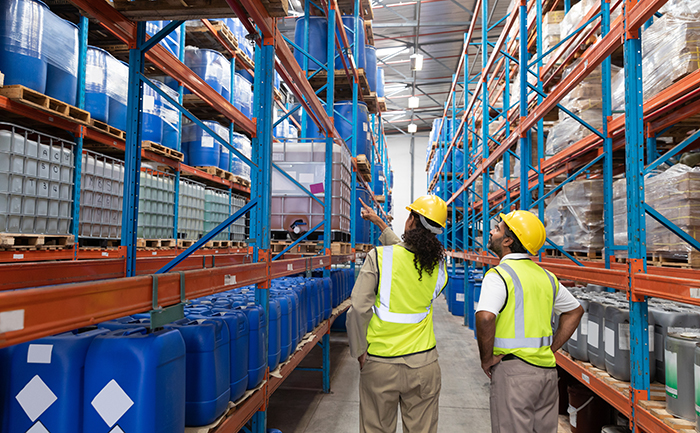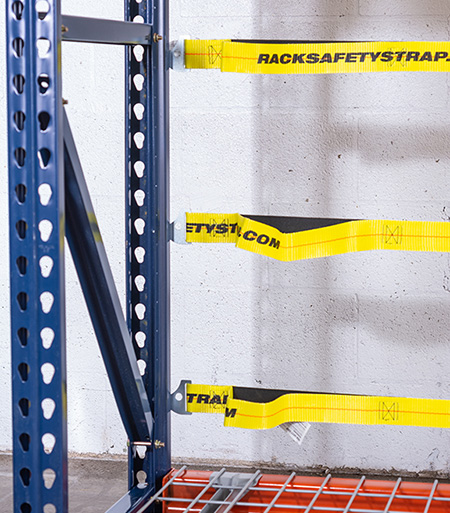Pallet Rack Evaluation: Safety
How to evaluate your rack system for safer operations

Pallet racks are integral to modern warehousing and aren’t static systems. Safety has always been one of the most critical aspects of warehousing and pallet racks have an outsized influence on warehouse safety. When you evaluate your rack, always take time to look for safety issues.
Potential pallet rack dangers
- Collapses and failures: Although relatively rare, collapses are extremely dangerous. Rack collapses are caused by a number of factors, ranging from damaged components to driver errors to overloading to seismic factors. The good news is that the warning signs are often there to alert you to the issue.
- Falling items: Falling product can hit workers in the aisles below.
- Forklift accidents: Because packed aisles of racks reduce visibility, racks can contribute to collisions between forklifts and pedestrians. This is extremely dangerous, particularly to workers on foot who may be struck by heavy items as they work or walk beneath. Forklift accidents are one of OSHA’s most frequently-cited categories, and forklift accidents are frequently intertwined with pallet rack designs and usage.
- Errors and mistakes: Racks also may contribute to lower light conditions that cause accidents.
- Bumps and scrapes: People who work around racks can raise up and bump their heads on the bottom of racks. Ergonomic issues can occur due to manual picking.
- Other factors: Some kinds of dynamic rack designs may generate specific dangers to workers in the area, such as jams or catching feet or hands as pallets move.
Schedule inspections—formal and informal—to monitor rack conditions
Look for damaged components, rust, missing anchors, missing safety clips and that sort of issue. Rack inspections you conduct should focus on obvious damage, bad processes and visible issues. Once you’ve determined that an issue exists, you can work to resolve it. Sometimes that may require outside expertise, equipment upgrades, replacement parts or other factors. Remember that only a qualified engineer can judge your rack for safety.
Damaged components should always be addressed, which can take several forms:
- Repair the component
- Replace the component
- Engage a qualified engineer to judge the component’s safety
Our advice is that any damaged rack should be professionally evaluated, repaired or replaced. While this level of scrutiny may seem over the top, the risks of a collapsing rack are so grave that the relatively low costs and inconvenience are justified. Complacency is the enemy. Just because a bent upright column has held up for a decade doesn’t mean it won’t crumple the next time a forklift brushes it.
Always inspect your floor anchors. You must anchor your rack per ANSI/RMI16.1. Find your manufacturer specifications for specific guidance on anchor types, quantities and specifications. Racks that aren’t anchored are inherently unsafe.
Read more: A Guide to Pallet Rack Inspection
Evaluate fall protection considerations

Is there potential for falling pallets, cartons or other stored items, especially near aisles where people pass beneath? When people work in busy warehouses where high-bay racks are stocked with heavy pallets and items, the dangers of falling items are always a concern. Evaluate your warehouse for fall protection, particularly where people, forklifts and racks frequently co-mingle.

Options for load fall protection
- Rack safety netting is flexible and lightweight, but can catch very heavy loads. You can specify modular netting that is easy to install across single bays or opt for design solutions that cover an entire row of racks.
- Pallet rack safety straps let you cover as much or as little as necessary of a bay or series of them for the needed fall protection. They connect to teardrop racks with easy metal connections and are ideal for flue space control.
- Wire mesh rack guards offer rigid, steel protection. They’re heavy and can stop serious collisions. They don’t flex as netting does. Because they are modular wire designs, you can add doors and completely enclose a rack bay for security as well as safety.
- Back-of-rack pallet stops can be flush with the uprights or offset to allow space for rear overhang. In single-row configurations, that means preventing a pallet load from toppling into an aisle and potentially injuring somebody. Double-row configurations prevent pallets from pushing into the load behind it. In single-aisle configurations, they help prevent falls into occupied aisles.
- Pallet rack side guides with backstops are L-shaped side guards that run the depth of an upright, with backstops that help stop stored pallets from striking the back of the upright or pushing through the back. These guides are great for regulating flue space and helping to ensure NFPA compliance.
Read more: Comparing Pallet Rack Guards: Flexible Netting vs. Wire Mesh Panels
Evaluate your layout, spacing and other warehousing practices for safety impacts

This is more complicated than inspecting your rack for damage. This is about the spacing, layout and the systems your forklift drivers use to load and unload your rack. You certainly need to hire, train and retain good drivers, but you can also set them up for success—or failure—based on your warehouse environment. You should evaluate the entirety of your warehouse with a focus on safety.
As warehouses evolve, so can necessary aisle widths for safe operations
Always adhere to the widths defined by your forklift fleet’s specifications, but remember that those can be seen as minimum standards.
For instance, 12′ aisles are very standard for sit-down, counterbalanced forklifts. Adding an additional foot of clearance may help prevent rack damage and potential collapses because drivers have that extra space for reversing, loading and unloading. If the aisle is used by both people on foot and forklifts, more space may help prevent accidents of the most serious kind: between people and forklifts. See “Key Considerations for Warehouse Aisle Widths” for more information.
Eliminate rack aisle clutter
Cluttered aisles can set the stage for accidents that damage your rack and reduce warehouse safety. Don’t allow pallet storage or any other obstacles in forklift aisles.

Above: Cluttered aisles force forklifts to drive around, which can cause side-swipe collisions. To prevent that, evaluate your putaway and inventory processes to ensure that aisles remain free of pallets, debris or other inventory that could cause those types of accidents.
Other layout & specification considerations:
- While aisle widths are probably the most critical aspect, also evaluate your transfer aisles for adequate clearances and visibility.
- Make sure those aisles allow enough space for the passage of people and lift trucks.
- Analyze picking patterns to reduce or eliminate zones of interaction between people and lift trucks. Some aisles should be bulk pallet storage only, with the majority of hand picking and storage done within aisles that are designed for (mostly) pedestrian traffic. See “A Step-by-Step Safety Process for Forklifts and Pedestrians” for detailed information on these kinds of exclusion zones within a rack system.
- Don’t connect your racks to the building structure without the consent of a professional engineer.
- Don’t shim racks with improvised shims. This can cause instability.
- Are your forklifts correctly specified to match the rack they’re loading?
Evaluate loading and unloading practices

Above: What causes this type of fall accident? It could be that the pallet itself is incapable of load support without decking or pallet supports (you can see sagging pallets on the right). It may also be loading errors or capacity miscalculations. Photo from Reddit.
There are many pallet rack safety issues that involve loading, unloading and specification. If the rack is not specified for the load it carries, it’s unsafe. If the rack is loaded incorrectly, it’s unsafe.
Be sure your racks are being loaded to specification; this includes loading methods, safety and capacity limits. Overloaded racks are probably one of the most dangerous things in a warehouse, so it’s critical to be sure that your racks are (1) not loaded beyond their capacity, and (2) loaded correctly so that they aren’t damaged during operations.
Detailed rack loading information:
- “Pallet Rack Load Distribution Guide” provides detailed information on ways to ensure safe usage.
- “A Guide to Pallet Rack Load Types” illustrates the ways loads can sit on beams and decking, as well as the ways to ensure safety.
Evaluate rack impact guards and protection
Despite your best efforts, there are times when forklifts will back into, swipe or crash into racks. Much of this safety issue can be reduced by installing proper safeguards.
Upright column protectors are the best way to deflect lift trucks and should be installed wherever forklifts load or unload rack bays. When you check your racks, be sure that you protect every column. It’s inexpensive and can prevent catastrophic damage.
Also: consider end-of-aisle protective guardrails and bollards.
Should you automate pallet transport, storage and retrieval?
Removing people entirely from the process, particularly in this day and age of shrinking labor pools, should be evaluated as part of any pallet storage strategy. Options include conveyors, AS/RS (automated storage and retrieval) systems and forklift-style AGVs, which all offer different strengths when it comes to storing, accessing and retrieving pallets. All of these considerations reduce the amount of human involvement, which reduces accidents based on human error.
Evaluate technologies like sensors, collision detection and cameras
Although these technology upgrades aren’t part of your rack system, they can protect it from damage. Options include backup alarms, collision avoidance systems (including ones that can “see” through aisles where drivers can’t), cameras, laser guides and more.
Forklift tine guide lasers help drivers see where their forks are positioned by projecting a bright laser line, even when they’re elevated far overhead. As you check your rack system for safety, evaluate any issues with forklift tine alignment. Another potential solution is tilt indicators that help drivers ensure their forks are level under the load.
Blind spot cameras are great for helping drivers see areas that are typically impossible from the driver’s seat, including where the load and rack beams are as they load and pick pallets. This helps combat low light conditions that may obscure the situation and provide better visual guidance.
Back-up collision sensors help reduce incidents where lift trucks back up into rack uprights by alerting drivers when they are close to an obstacle. This may be the most common way to damage racks, which frequently leads to unsafe rack upright damage.
New methods and technologies are constantly emerging to help make rack systems safer. Remember as you evaluate your system that it’s usually a combination of factors, from training to equipment to technologies, that will help improve warehouse safety.
Download our Pallet Rack Guide
Pallet rack enhances your warehouse and improves overall facility performance when correctly specified, laid out and installed for the right load in the right positions. Check out our guide to specifications, styles, accessories and applications with expert tips from our employee-owners.
You’ll find quick, useful information on racks and how you can use them more effectively.
Download the guide today
Tags: Safety & Ergonomics
Scott Stone is Cisco-Eagle's Vice President of Marketing with 35 years of experience in material handling, warehousing and industrial operations. His work is published in multiple industry journals an websites on a variety of warehousing topics. He writes about automation, warehousing, safety, manufacturing and other areas of concern for industrial operations and those who operate them.




